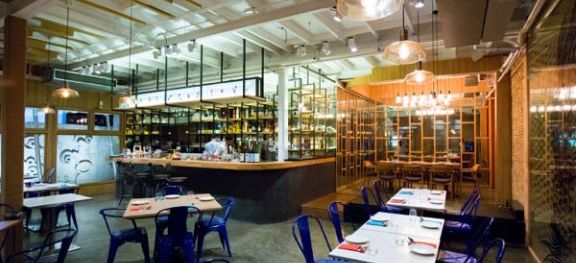Chef Ton – triumphant return to Bangkok

A version of this article is published by The Financial Times.
ThiTid Tassanakajohn, more easily known as Chef Ton, is the creative force behind two of the most exciting restaurants in Bangkok, Thailand.
Two and half years ago he opened Le Du, which translates from the Thai as ‘season’, in the Bang Rak suburb of the capital. And then only a few months ago he oversaw the transformation of a building that used to house an advertising agency in the residential suburb of Sukhumvit into the ultra-modern BaaGaDin, which translates as ‘selling food from a picnic blanket’ (photo courtesy of Exgave).
Ton’s diversification from a relatively formal first restaurant to somewhere that concentrates more heavily on street food is one that is being mirrored by many chefs and restaurateurs all over the world. But Ton is doing this from a particularly high skill base and in a country where street food is very much still alive and flourishing. It is perhaps a good job he is still young and more interested in creativity than in a quick financial return.
Born 30 years ago in Bangkok, Ton moved as a student to the Culinary Institute of America in New York where he finished top of his class, before cooking at Eleven Madison Park, The Modern and Jean Georges. His interest in wine also resulted in him becoming a certified sommelier.
On his return, he found backers and opened Le Du in very different surroundings from central New York. From our taxi window, I could not help noticing a street-food vendor and a man sitting in a bright pink plastic chair close to the restaurant’s entrance.
The restaurant itself has a glass frontage and, inside, puts glass to advantage in showing off the kitchen. There are four floor-to-ceiling windows along the wall that separates the kitchen from the dining room and one horizontal window in the swing door between the two. Everything is on show, with the chefs behind the pass, and Ton able to walk in front of them, clearly able to keep a keen eye on both his customers and his staff.
This configuration also allows the customer to witness a significant difference between Thai and western kitchens. At Le Du half of the kitchen staff are female; many of those cooking at stalls in the streets are women; Uemporn Yuayaipong is the female Executive Chef of Sala Rim Naan, the Thai restaurant in the Mandarin Oriental; and many of the younger, male Thai chefs including Ton, acknowledge the debt they owe to their mother’s or grandmother’s cooking.
On the left-hand page of Le Du’s clearly printed four-page menu are listed three cold first courses, three from the sea and the forest, three from the ranch, and four desserts, here headed ‘sin’. The main ingredient, almost all of them western, is picked out in bold, and followed by a string of Thai pastes, jams and sauces of which only a few were known to us.
The dish that breaks this rule is the first, khao-chae, a complicated amalgam of parboiled rice cooked in jasmine water that dates back to the reign of King Rama 11 in the early 19th century and whose cooling charms make it a speciality in April and May, the country’s hottest months. As important as the precise cooking techniques are the side dishes, here a shrimp and pork roll, radish, salted fish and a scoop of jasmine ice cream. Royal etiquette apparently demands eating a small amount of each side dish followed by a scoop of the cooled rice, rules we probably failed to follow.
We were impressed by what accompanied each main ingredient: the choo chee sauce that is the basis of so many Thai curry dishes that incorporate fish, here served with pickled, grilled leeks and raw mackerel; a light duck broth alongside a pickled lime gel and a duck and prawn won ton; and the pickled ginger and a jus of ginger and soy that was served alongside an extremely well-cooked breast and thigh of chicken. Dinner, which included a refreshing bottle of Reyneke 2014 Chenin Blanc from South Africa at 2250 baht, cost 5,753 baht (£115).
Prices are even more reasonable at BaaGaDin thanks to a menu that incorporates smaller dishes (£5-£7) and larger plates (£10-£12); a more informal style of service; and an American chef, Chandler Schultz, who travelled from Delaware to undergo a very specific Thai culinary ‘finishing school’.
Having been introduced to Chef Ton via the Thai celebrity chef McDang, Schultz cooked at Le Du while undertaking what must have been an extremely pleasant immersion course: learning about Thai street food by visiting as many exponents of the art as possible.
This exposure has paid off as the dishes zing with flavour, and with considerable heat. One-bone chicken wings with Thai basil was a gentle introduction. A beautifully textured beef tartare with tamarind and spices packed much fierier flavours, as did prawns in coconut milk with a Thai lemon foam, and a veal soup with onions, garlic and Chinese five spice, a dish whose heat was dissipated somewhat by the inclusion of fresh beef blood. We finished with a sea bass, wrapped in banana leaves, cooked in the charcoal oven.
Le Du, 3 10500, 399/3 Sol Silom 5, Bang Rak, Bangkok 10500, 00 66 92 9199969, www.ledubkk.com
BaaGaDin, 26 Sol.Sukhumvit 31, Bangkok 10110, 0066 026623813
Become a member to view this article and thousands more!
- 15,423 featured articles
- 274,421 wine reviews
- Maps from The World Atlas of Wine, 8th edition (RRP £50)
- The Oxford Companion to Wine, 5th edition (RRP £50)
- Members’ forum
- 15,423 featured articles
- 274,421 wine reviews
- Maps from The World Atlas of Wine, 8th edition (RRP £50)
- The Oxford Companion to Wine, 5th edition (RRP £50)
- Members’ forum
- Commercial use of our Tasting Notes
